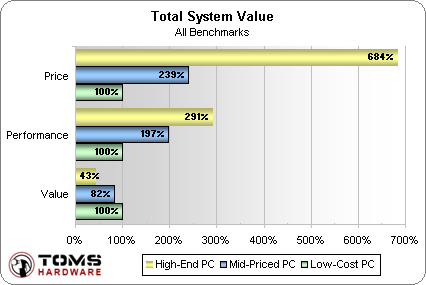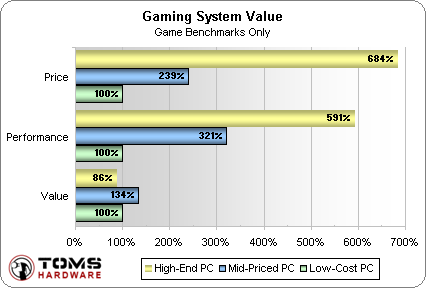System Builder Marathon: Day 4
Value Analysis
Three days of extensive testing have brought us to the final leg of our System Builder Marathon, and most readers are no doubt anticipating a "bang for the buck" analysis. People tend to think they're smart, so budget builders will look for proof that spending more is a waste of money, while performance seekers want to prove the low-end system isn't worth owning.
First, let's look at the gaming performance and compare the average frames-per-second from every setting in the previous game charts. Dividing every system's average frame rate by the lowest system's results gives the slowest system "100%" with others showing percent gains compared to it. We use this method in each of the Percent Performance Difference charts below.

Gamers will appreciate the huge performance leaps each jump in price provides, but what about people who want to get some serious work done in multimedia?

The mid- and high-cost systems have a substantial lead over the low-cost configuration, but we've yet to compare the prices to performance differences. Before we get there, let's take a look at the "braggers sheet" of synthetic performance differences:

With the graphics subsystem marking the largest difference between systems, a huge spread in 3D Mark 2005 was expected. The smaller difference in Specviewperf 9 wasn't.
On we go to the system value comparison! Dividing every system price by the lowest system price provides a percent difference graph. Averaging all the performance differences from previous charts provides the relative performance graph. Finally, dividing the performance percentage by the price percentage gives us the value perspective.

The high-end system had nearly three times the performance of the low-cost system, yet cost nearly seven times as much! That leaves it with a pathetic 43% value score. The mid-priced system faired better at 82%, but it's quite obvious that the low-budget build resulted delivered the best bang for the buck.
Or did it? Just to put one final spin on value, we might like to compare only the game performance to the price. After all, isn't gaming the "killer app" that people are actually willing to spend a bit more to improve?

If the reason for your new build is primarily an increase in game performance, your best value would be the mid-priced build, by a relatively large margin. But even with gaming performance as primary goal, the low-budget system would be a sufficiently better value than the high-end build...if only it could provide playable speed at reasonably high resolution and graphics detail.
Current page: Value Analysis
Prev Page Synthetics, Continued Next Page Bonus: We Build And Test A Budget Gamer's SpecialStay on the Cutting Edge
Join the experts who read Tom's Hardware for the inside track on enthusiast PC tech news — and have for over 25 years. We'll send breaking news and in-depth reviews of CPUs, GPUs, AI, maker hardware and more straight to your inbox.
